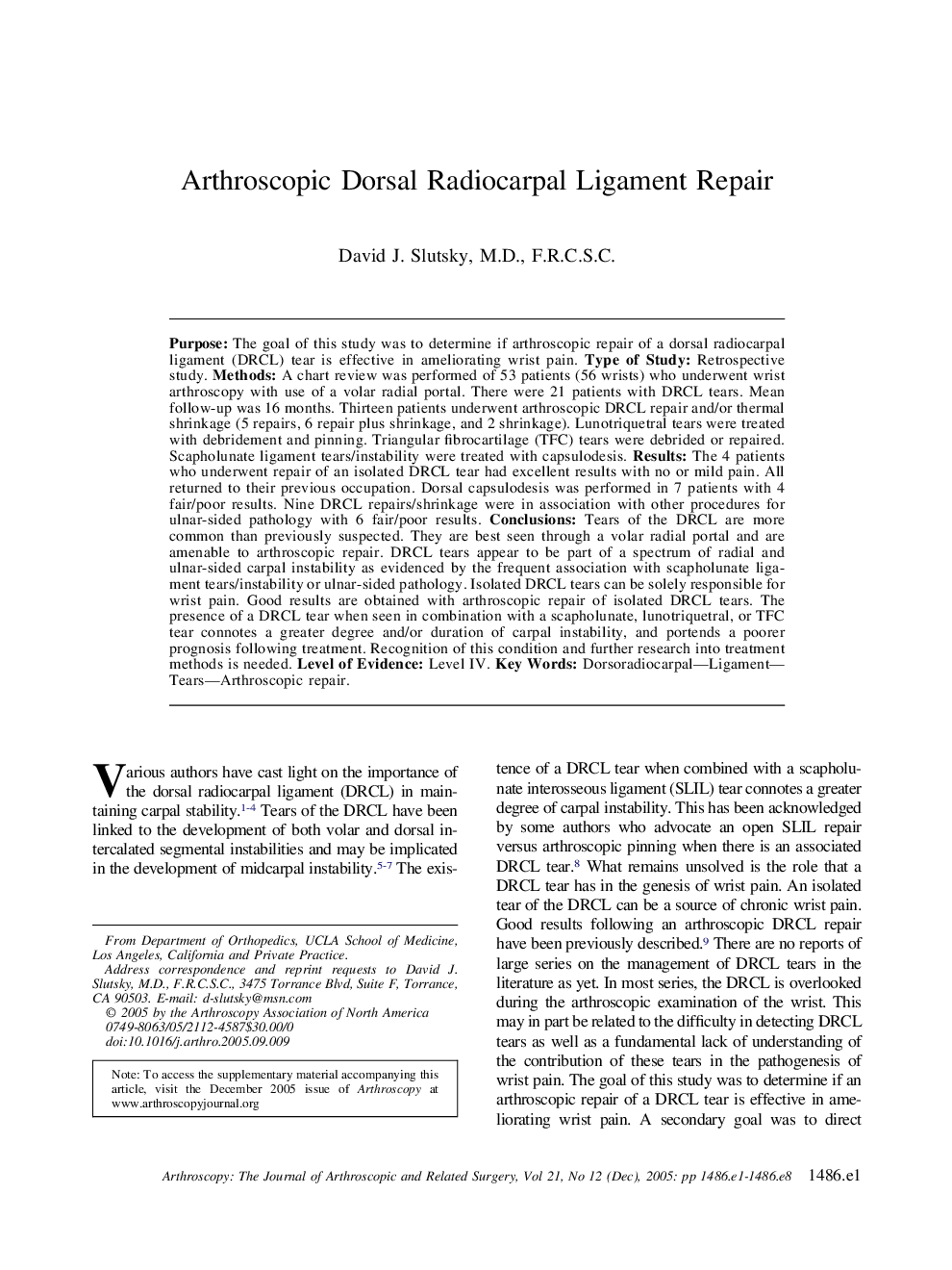| کد مقاله | کد نشریه | سال انتشار | مقاله انگلیسی | نسخه تمام متن |
|---|---|---|---|---|
| 10078747 | 1603616 | 2005 | 8 صفحه PDF | دانلود رایگان |
عنوان انگلیسی مقاله ISI
Arthroscopic Dorsal Radiocarpal Ligament Repair
دانلود مقاله + سفارش ترجمه
دانلود مقاله ISI انگلیسی
رایگان برای ایرانیان
موضوعات مرتبط
علوم پزشکی و سلامت
پزشکی و دندانپزشکی
ارتوپدی، پزشکی ورزشی و توانبخشی
پیش نمایش صفحه اول مقاله

چکیده انگلیسی
Purpose: The goal of this study was to determine if arthroscopic repair of a dorsal radiocarpal ligament (DRCL) tear is effective in ameliorating wrist pain. Type of Study: Retrospective study. Methods: A chart review was performed of 53 patients (56 wrists) who underwent wrist arthroscopy with use of a volar radial portal. There were 21 patients with DRCL tears. Mean follow-up was 16 months. Thirteen patients underwent arthroscopic DRCL repair and/or thermal shrinkage (5 repairs, 6 repair plus shrinkage, and 2 shrinkage). Lunotriquetral tears were treated with debridement and pinning. Triangular fibrocartilage (TFC) tears were debrided or repaired. Scapholunate ligament tears/instability were treated with capsulodesis. Results: The 4 patients who underwent repair of an isolated DRCL tear had excellent results with no or mild pain. All returned to their previous occupation. Dorsal capsulodesis was performed in 7 patients with 4 fair/poor results. Nine DRCL repairs/shrinkage were in association with other procedures for ulnar-sided pathology with 6 fair/poor results. Conclusions: Tears of the DRCL are more common than previously suspected. They are best seen through a volar radial portal and are amenable to arthroscopic repair. DRCL tears appear to be part of a spectrum of radial and ulnar-sided carpal instability as evidenced by the frequent association with scapholunate ligament tears/instability or ulnar-sided pathology. Isolated DRCL tears can be solely responsible for wrist pain. Good results are obtained with arthroscopic repair of isolated DRCL tears. The presence of a DRCL tear when seen in combination with a scapholunate, lunotriquetral, or TFC tear connotes a greater degree and/or duration of carpal instability, and portends a poorer prognosis following treatment. Recognition of this condition and further research into treatment methods is needed. Level of Evidence: Level IV.
ناشر
Database: Elsevier - ScienceDirect (ساینس دایرکت)
Journal: Arthroscopy: The Journal of Arthroscopic & Related Surgery - Volume 21, Issue 12, December 2005, Pages 1486.e1-1486.e8
Journal: Arthroscopy: The Journal of Arthroscopic & Related Surgery - Volume 21, Issue 12, December 2005, Pages 1486.e1-1486.e8
نویسندگان
David J. (F.R.C.S.C.),